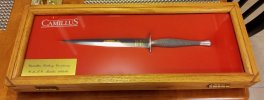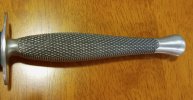As has been mentioned by several posters, the Zinc alloy used in the original Marine Raider Stiletto tends to deteriorate over time. In fact, I have been actively researching the issue in hopes of coming up with a solution that will help preserve these knives for the long term. This solution will likely come in several different forms:
Metallurgy:
Apparently, due to wartime contingencies, strategic metals such as brass and copper were avoided and an experimental new Zinc alloy was used. This is actually part of the historical charm of the knife. Unfortunately, impurities in the alloy and exposure to moisture play a role in premature deterioration. It is my belief that the inconsistencies and impurities will surface at varying times and that some handles may be more resilient than others. Those remaining intact after 75+ years may be the best of the rest.
Environment/Storage:
Short of encasing them with inert Argon gas, there are other practical ways to slow down or prevent the deterioration of Marine Raider handles. I live in a rather arid Climate that is much more conducive to preservation than the South Pacific Jungles where these knives saw action. (In fact, I work just minutes away from where the knife was first designed and deployed at Camp Pendleton, CA). It is my hope that keeping it dry and padded will ensure a long life. Of course, I also wear gloves when handling and do not keep it in the original moisture-collecting leather sheath.
Reformulation/Replacement:
As mentioned by another poster, before they closed up shop, the original manufacturer, Camillus of New York discovered a barrel of original Raider Stiletto Blades. These rare surplus blades were mated with new post-war handles. They found that reformulating and recasting the handles with another zinc alloy, namely pewter, results in a more stable and resilient handle. I own one of these as well and they are a beautiful and fitting tribute to the original, fetching hundreds of dollars in their own right. More recently, HG Long of Sheffield, England was commissioned by the Marine Raider Association to make a similar tribute knife using their own molds from an exemplary original specimen. I have a recently manufactured rubber version of this knife, so I know the molds are still available. Sure, such restoration will decrease the value in the eyes of collectors vs. an original, but as fewer remain, what is the alternative for collecting such a compelling knife?
“Raider Infinity”:
As original handles deteriorate, enterprising collectors will find a way to repair/recast them using the original blades and supplemental alloys rather than throwing them into the dustbin of history. It might be a Quixotic quest or my own personal “white whale”, but I don’t really care. Many other handle types deteriorate in adverse/moist conditions as well. Greenhorn, wood, and leather handles don’t like moisture. I have seen many leather-handled “Ka-Bar” type knives in poor condition due to moisture.The Robeson SurEdge with red spacer has a weak tang with an Achilles heel at the butt plate, but it is one of the most collectible of all the WW2 Mark 2 knives. The Collins #18 Greenhorn Bowie is another example of a beautiful knife with aging handle and broken brass guard issues. They all have their quirks, but I still love them all! Like these classic WW2 knives, the historic USMC Raider Stiletto will survive as an important piece of history.
Conclusion:
Proper care and storage, along with science and ingenuity, will go a long way towards preserving any knife. If my Raider handle ever crumbles, I will certainly make a new handle by melting down the pieces and recasting it supplemented with pewter to fix the original problem. In the meantime, I will certainly put forth the effort to remove rust from the blade in the proper manner. After all, everyone on this forum should understand that knife collecting is a labor of love.



